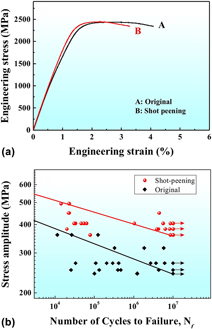Crossref Citations
This article has been cited by the following publications. This list is generated based on data provided by
Crossref.
Wang, Hai-bo
Yang, Xin-hua
Li, He
Song, Guo-lin
and
Tang, Guo-yi
2018.
Enhanced fatigue performance and surface mechanical properties of AISI 304 stainless steel induced by electropulsing-assisted ultrasonic surface rolling process.
Journal of Materials Research,
Vol. 33,
Issue. 22,
p.
3827.
Ben, Dandan
Yang, Huajie
Ma, Yunrui
Wang, Qiang
Tian, Yanzhong
Zhang, Peng
Duan, Qiqiang
and
Zhang, Zhefeng
2019.
Declined Fatigue Crack Propagation Rate of a High‐Strength Steel by Electropulsing Treatment.
Advanced Engineering Materials,
Vol. 21,
Issue. 7,
Chen, Zhenglin
Sun, Zhidan
and
Panicaud, Benoît
2019.
Investigation of ductile damage during surface mechanical attrition treatment for TWIP steels using a dislocation density based viscoplasticity and damage models.
Mechanics of Materials,
Vol. 129,
Issue. ,
p.
279.
Marini, M.
Fontanari, V.
and
Benedetti, M.
2021.
DEM/FEM simulation of the shot peening process on sharp notches.
International Journal of Mechanical Sciences,
Vol. 204,
Issue. ,
p.
106547.
Rohit, Benjamin
and
Muktinutalapati, Nageswara Rao
2021.
Fatigue Behavior of 18% Ni Maraging Steels: A Review.
Journal of Materials Engineering and Performance,
Vol. 30,
Issue. 4,
p.
2341.
Ren, C.X.
Wang, Q.
Hou, J.P.
Zhang, Z.J.
Zhang, Z.F.
and
Langdon, T.G.
2021.
The nature of the maximum microhardness and thickness of the gradient layer in surface-strengthened Cu-Al alloys.
Acta Materialia,
Vol. 215,
Issue. ,
p.
117073.
Maleki, Erfan
Bagherifard, Sara
Unal, Okan
Shao, Shuai
Shamsaei, Nima
and
Guagliano, Mario
2023.
Assessing the efficacy of several impact-based mechanical techniques on fatigue behavior of additive manufactured AlSi10Mg.
Materials Science and Engineering: A,
Vol. 872,
Issue. ,
p.
144940.
Xia, Bo
Zhang, Peng
Wang, Bin
Li, Xiaowu
and
Zhang, Zhefeng
2023.
Effects of quenching temperature on the microstructure and impact toughness of 50CrMnSiVNb spring steel.
Materials Science and Engineering: A,
Vol. 870,
Issue. ,
p.
144856.
Rohit, B.
and
Rao M, N.
2023.
Influence of reverted austenite on fatigue life of 18 % nickel maraging steel.
Materialwissenschaft und Werkstofftechnik,
Vol. 54,
Issue. 10,
p.
1283.
Maleki, Erfan
Bagherifard, Sara
Unal, Okan
and
Guagliano, Mario
2024.
Hybrid Intelligence approach to study post-processing impact on the mechanical performance of notched additively manufactured AlSi10Mg.
Materials & Design,
Vol. 248,
Issue. ,
p.
113462.
Wegener, T.
Oevermann, T.
and
Niendorf, T.
2024.
Influence of deep rolling at different temperatures on near-surface and mechanical properties of a Maraging C250 steel.
International Journal of Fatigue,
Vol. 185,
Issue. ,
p.
108358.
Niu, Z.M.
Lei, Y.B.
Gao, B.
Sun, Y.T.
and
Wang, Z.B.
2025.
Architecting an ultrahard surface layer on maraging steel by a surface thermomechanical approach.
Journal of Materials Research and Technology,
Vol. 36,
Issue. ,
p.
2243.
